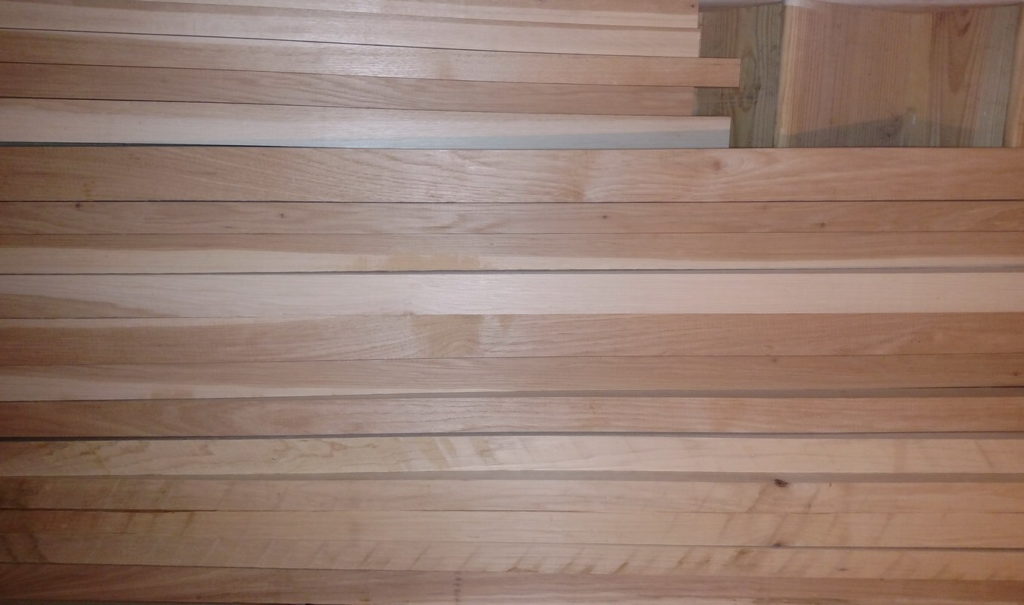Hicksville planing mill has everything. From pallets of purpleheart to Zebrawood, but where they really shine is their ability to process the wood your buying right there while you wait.
I’ve been re-handling old hammers and it’s costing [in many cases] more than the tool for the new handle. Plus, anything you can make yourself makes the tool just a little more fitted, and personal. So I started looking into making my own. Since none of the lumber yards around here have hickory or ash, I bought a couple of shovel handles, cutting and shaping them to size. This is a nifty trick if you need small handles, but it leaves little room to customize the handle beyond a tiny palm swell.
On Friday Jess and I loaded into the old Tahoe and drove up to Clear Spring, MD and dropped by my favorite Mennonite lumber yard. As one would expect they had plenty of Hickory, Ash, and Cherry the three kinds of wood I was considering for handles. Since Hickory is “king” when it comes to handles it was my first stop and we ended up finding more then I could possibly use.
Heartwood vs. Sapwood
I’ve been reading about using heartwood vs. sapwood for handles and after reading many opinions I’ve settled that it doesn’t make any difference whatsoever. Having a choice between straight heartwood, straight sapwood and a mix of the two (which I think looks amazing) I settled on the boards that had a good blend of each.
Since I’m sure someone wants to know the cost of Hickory at Hicksville planing mill was:
- 5/4, $3.10 per board foot.
- 6/4, $4.00 per board foot.
A survey of handles on hand.
I measured all of the handles I had around to see what dimension of blanks I would need. Most hammers were straight with the thickest point being at the swell (rarely more than 1.5″) and the widest point being in the grip or cheek (usually 1″ up to 1.25″). Half hatchet, heavy hammers and other beefy hammer handles made it to 1.75″. Hatchets, boys axes would measure up to 2″ shoulder and across the heel and toe. I measured across the belly and throat on a couple of curved 36″ ax handles and they fit within a 2.5″ blank.
With all these numbers I put together a quick handle blank sizing table that will work for me. That’s another post though so I’ll link to it here.
Getting all of the wood ripped, planed and cut to blank stock.
Again I love this mill because not only can you find exotics and hard to find hardwoods but they will process the wood right there for you while you wait. They even let you help, which I appreciate in this day and age of liability fear. I picked my two favorite boards from the 5/4 and 6/4 pallets. Most of the boards were 8 to 10 feet long by around 7″-12″ wide. Way more wood then I need, but it’s a long trip and I wanted enough material to experiment with. Being able to make mistakes is a good way to learn so I’d rather have more than not enough.
We ripped them to the following sizes:
| Dimensions | Use | Feet Available |
| 1 x 1 | Very small (3oz ball peen, small tinners\setting hammers) | 0′ |
| 1 x 1.25 | Small striking tool handle (ball peen, etc) | 0′ |
| 1 x 1.5 | Hammer, Trade hatchets, ball peen, etc | 0′ |
| 1.25 x 1.25 | Medium striking tool handle (ball peen) | 0′ |
| 1.25 x 1.5 | Heavy Hammer, Roofing hatchet, medium cross peen | 27′ |
| 1.25 x 1.75 | Half hatchet, Extra Heavy hammer | 22.5′ |
| 1.5 x 1.5 | Drilling hammer, Hammer with large palm swell | 9′ |
| 1.5 x 1.75 | Half hatchet with a curve, Straight \ Miners ax | 36′ |
| 1.5 x 2 | Boys ax, House ax, Straight \ Miners ax | 3′ ?? |
| 1.5 x 2.5 | Curved handled, full-sized axe | 10′ |
A note on the sizes.
After some experimentation 4/4 would have been a better choice for many of the small hammers. I’m grinding away so much wood to get them down to size.
I’ll make another trip and pick up some 4/4 hickory and perhaps some ash also to experiment with. Just not nearly as much!
Additional Links and Info:
Our first trip can be found here: Visit to Hicksville Planing Mill
